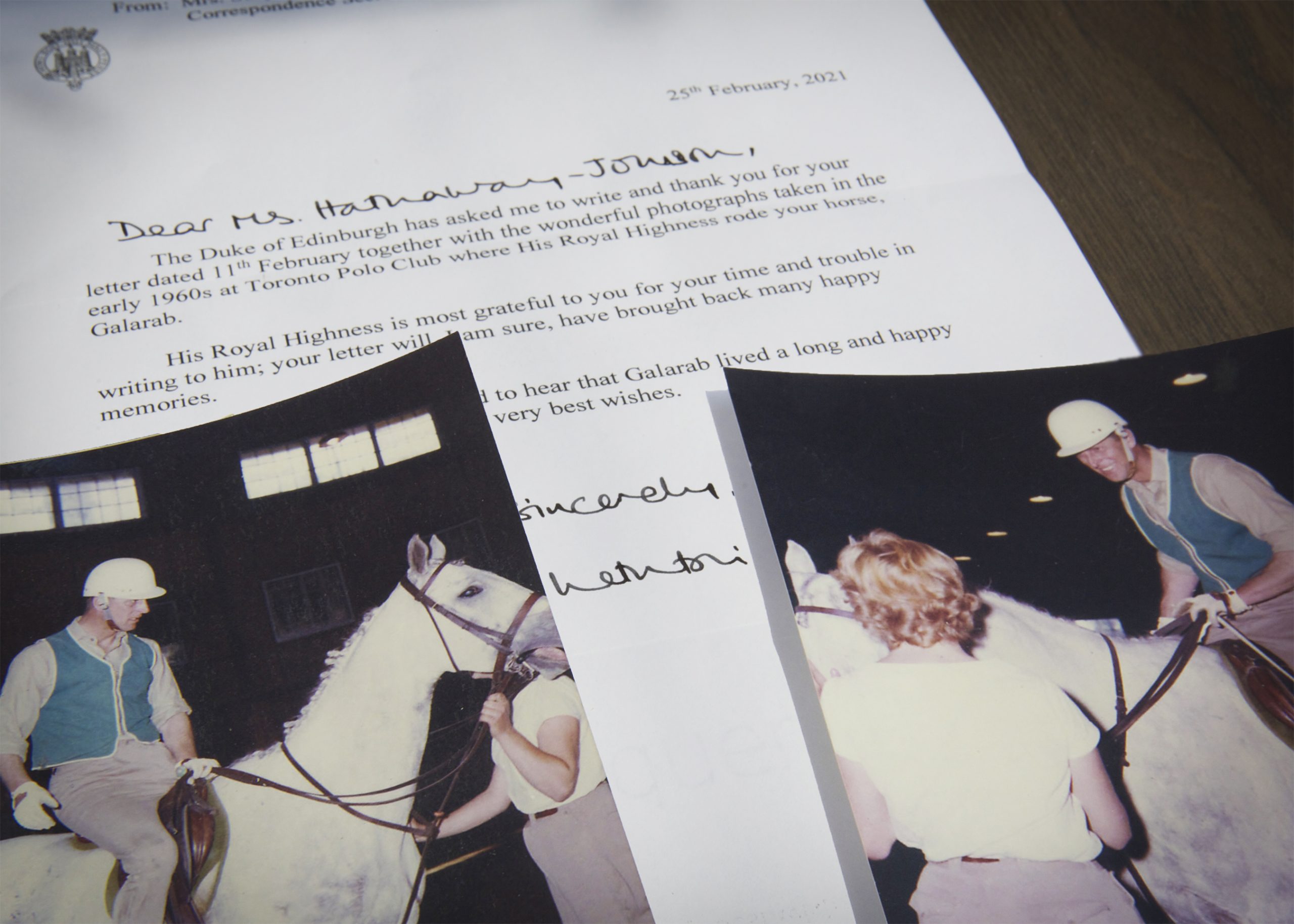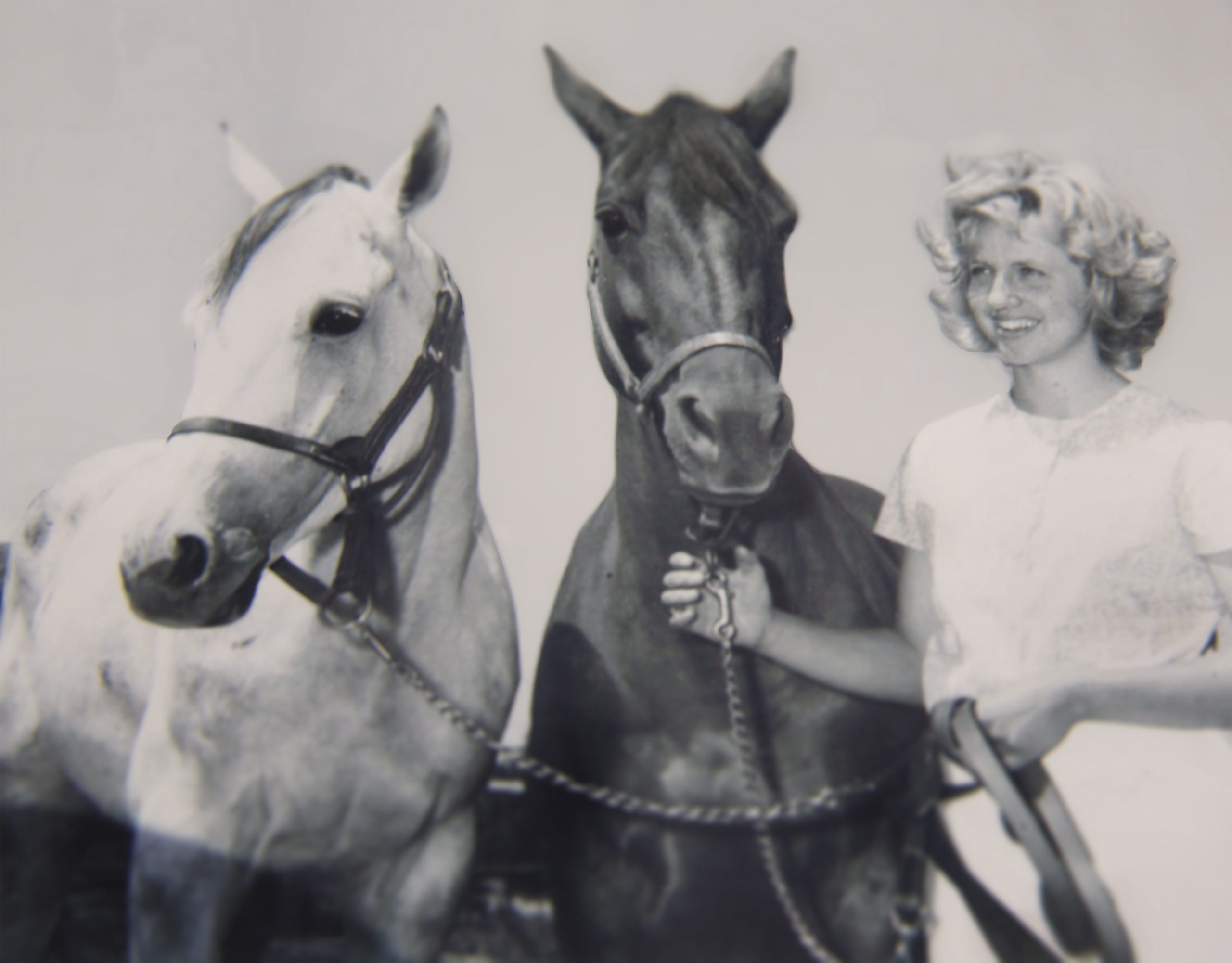MOUNT FOREST – Janet Hathaway was a teenager living in Markham Township in the early 1960s when she became involved with the Toronto Polo Club.
“I went to work as a trainer and looked after a barn full of horses at 17 years old. Horses were my world; they were my life,” Hathaway said.
She had previous experience working with horses but was eager to expand her knowledge of the equine world.
The sport of polo had seen its ups and downs after arriving in Ontario at the turn of the 20th century.
Activity with the sport had ceased during the war but was revived in the late 1950’s when a group of equestrians began to play in the arena at the former Sifton Estate – a large indoor arena located at Bayview and Lawrence.
“When my boss started playing at the polo club, it was predominately a men’s club. At the time, I was training horses and he decided he wanted to play polo,” Hathaway said.
“I was a girl doing a man’s job.”
It was around this time that Hathaway met Galarab.
Galarab’s Story
Galarab was a grey thoroughbred horse, born and bred to run races. He had been entered into 22 races because of his pedigree, but it quickly became apparent he had no desire to compete, and his owners sold him off.
Hathaway first came upon Galarab lying down in a pasture as she rode past on her boss’s hunting mare.
She thought it was odd that he was lying flat, especially given the time of day. On her way home an hour or so later, he was still lying in the same place.
“That told me something was wrong,” she said.
“I thought, if there’s nothing wrong, he’ll feel the vibration of my horse coming, and will get up.
“We went down into the ditch, jumped over the cedar rail fence, and galloped up to him. He didn’t get up. I got down, checked his vital signs, and knew that he was dying.”
After galloping across the field to the house, Hathaway jumped her horse over the fence onto the front lawn of the owner’s house who ended up calling the vet.
Galarab lay on the ground for three days and was taken care of intravenously.
“When he finally got up, his owner asked if he could send him to my boss’s barn where I’d be able to take care of him,” Hathaway said.
A financial arrangement was agreed upon, and she walked Galarab to the new barn.
What should have been a five-minute walk ended up being closer to 40 due to the horse’s frail condition.
“From that day on, I took care of him, and brought him back to perfect health,” she recalled.
Hathaway’s boss had acquired the horse but had no desire to keep him. After some convincing, he allowed her to train Galarab to play polo since most players would have three horses.
“Galarab would do anything for me, and everybody knew it.
“Over that period of bringing him back to health and training him, he became my horse. He bonded with me.”
Trail Riding
Hathaway and Galarab became inseparable, and it wasn’t uncommon for her to take him on day trips along various trailways.
She decided to take some friends for a ride down the Rouge River which led to Lake Ontario.
As they headed down the sandy trail along the river, they came across a large tree that had fallen across the trail in such a way that its branches covered most of the river with its base still up on the embankment.
The tree created a kind of triangular gap, that was too low for the horses to pass under.
“I thought, ‘we’re not going to be able go under it, but maybe I’ll just get off and just see how much room there is,’” Hathaway said.
She let the reigns slip through her fingers to walk under and better assess the situation.
She confirmed that it was an impasse and turned to walk back under when she saw Galarab had got down on his knees and crawled under the tree behind her.
“I couldn’t believe my eyes. For a horse to get down on it’s knees like that is extremely unusual.”
Hathaway knew her friends would not be able to do the same and since they didn’t know their way back, she could only hope that the horse would follow her back under. Galarab did not disappoint.
“Nobody would believe that story,” said Hathaway, still in disbelief of Galarab’s behaviour to this day.
“Things like that don’t happen with horses. I knew we were bonded, but I didn’t realize to what degree.
“It was just the coolest moment of my life.”
Regal Rendezvous

Royal Mail – Photos of Prince Philip riding Galarab in 1962 along with a 2021 letter from Buckingham Palace. Submitted photo
In 1962, over a span of 23 days, Prince Philip attended a Commonwealth Study Conference and visited five cities across Ontario, Quebec, and British Columbia.
“The Polo Club found out Prince Philip requested to visit the polo club and so a meeting was called to discuss the protocol for his arrival,” said Hathaway.
“They were in a bit of a tizzy because they didn’t have the right horse for him. [The members] playing polo at the time were using were fox-hunting horses, which were used for jumping and weren’t trained to play polo.”
Prince Philip had been a driving force behind polo’s recovery after the Second World War and would go on to be a part of the first all-English team to win the Gold Cup in 1969.
It was important for the club to offer him a well trained polo pony.
“It was clear they had no idea what horse he would use, so I said, ‘What about Galarab?’”
Hathaway’s suggestion was well received, but her point of view on addressing the prince left something to be desired.
“At the meeting, I was told that everyone was to call him ‘Your Highness’ or ‘Your Grace’. Having had six brothers, I piped up and said, ‘there’s no way that’s happening.’”
Hathaway was a well-respected trainer and ultimately agreed to call him sir.
“They chastised me, but that’s what Prince Philip got from me – sir.”
On the day the prince arrived, Hathaway was responsible for handling Galarab.
“Prince Philip was a very tall, very handsome guy, and I as a teenager proceeded to tell him how to ride Galarab,” she said.
“I told him Galarab was trained to perfection, and that I didn’t want to see him pulling on his mouth.
“He looked down at me and smiled because I was just a little blond-haired, blue-eyed teenager.”
After the prince had mounted Galarab, Hathaway headed over to get a mallet from the wall and began walking back to hand it to him.
“I didn’t know it, but coming up behind me, were two huge bodyguards that suddenly lifted me off my feet.
“I asked, ‘What’s the matter?’ They said, ‘Janet, you can’t give him the polo mallet.’”
Hathaway was caught off guard and asked, “how’s he going to play polo without a mallet?”
As it turned out, she was not allowed to approach Prince Philip with the mallet as it was considered a weapon.
The prince did get the mallet, of course, and the game went off without a hitch.
Largely because of the prince’s riding experience and accuracy striking the ball, Galarab didn’t break a sweat.
When the match was over, Hathaway took back possession of Galarab.
“The prince dismounted, turned to me and said, ‘I really like this horse, I think I’ll take him back to England with me.’”
“Well, I don’t usually think before I speak and said, ‘not without me, you won’t!’, and he looked at me and said, ‘that can be arranged.’”
“I think because I spoke to him the way I did, and because of my age, he felt comfortable talking to me,” she said.
After hearing about the match through horse circles, several young women started to show up as spectators. Along with Hathaway, they formed the Toronto Lady’s Polo Club.
Eventually she decided to quit her job to go back to school and because her boss refused to sell Galarab, she decided the best thing to do was to try to move on and forget about him.
Fond farewells
In 1974 Hathaway told her husband about Galarab and the encounter with Prince Philip.
Naturally, he wanted to meet him. It’d been years since she’d seen the horse but agreed to go along.
“I walked into the barn, and I just said ‘Hi, Gally,’ and he turned his head, his ears perked, and his entire demeanor changed.
“I can honestly tell you, his eyes widened and everything about him spoke volumes to me. [He seemed to say] ‘Where have you been? I’ve been waiting,” Hathaway said.
“I taught that horse to jump, and he never refused a fence. He did everything, and anything for me and went on to be ridden by umpteen other girls.
“He was just the sweetest, gentlest of creatures.”
Galarab lived to be 32 years old.
In February of 2021, Prince Philip was admitted to King Edward VII’s Hospital as a precautionary measure after feeling unwell.
After hearing the news, Hathaway wondered if the prince would remember coming to Toronto and riding Galarab and decided to send a letter.
She received a response from Buckingham Palace sometime later that he’d read the letter and that it had brought back many happy memories.
Prince Philip passed away in April the same year at Windsor Castle.
Hanging up the Saddle
Hathaway gave away her last horse, Lakota to a single mother with a teenage daughter about five years ago.
Since 2007 she’s been living in Mount Forest and tries to stay active within the community.
She volunteered at a local thrift store, has been involved with the Louise Marshall Hospital Ladies Auxiliary, and is part of a potluck dinner group, among other things.
She is an artist, gardener, cook, writer, and great-grandmother.
More recently Hathaway was involved in the community garden in Mount Forest where she volunteered to raise money.
“Horses are my passion. The reason I named my last horse Lakota is because it’s an Indigenous name.
“Horses and I are one. I’ve been passionate about them since I was a young child and understand their language.”
Are you acquainted with a remarkable senior residing in Wellington County? If so, please email czimmerman@wellingtonadvertiser.com to share their story.




